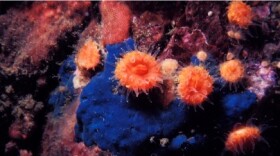Their goal is clear: to prevent Puget Sound’s iconic Southern Resident killer whales from going extinct. Solving that problem is anything but simple.
The task force convened by Gov. Jay Inslee to save the orcas added 13 new recommendations this week, at its final meeting. The additions to the group’s so-called “Year 2 Report” cover more than 100 pages, adding climate change and population growth to the list of issues complicating orca recovery.
The governor’s task force – created after an executive order from Inslee in March 2018 – is comprised of several dozen experts. They represent everything from salmon recovery groups to commercial fishing interests to local agencies, tribes, marine traffic and whale watch tour operators.
They met 10 times at venues across the state, discussing anything that might touch the life of an endangered orca.
There were some rifts along the way: a proposed moratorium on whale watching that was ultimately rejected by lawmakers; conflicts about immediate removal of the Lower Snake River dams.
Despite all that, the group wrapped up the work harmoniously on Monday at the Intellectual House in Seattle.
The task force identified pressure from population growth in the Puget Sound region as one of the less obvious, yet hardest, problems to solve. Contaminants in the runoff from cars, roads and developments that impede salmon runs have led to the loss of fish habitat, despite millions spent on recovering it.
“We’ve had laws on the books to protect the environment for decades now. And our attempt to get to no net loss simply isn’t working,” said Will Hall, Shoreline mayor and the only city representative on the task force.
Hall pushed for a rewrite of a recommendation on population growth, insisting it should point toward local policies to prevent habitat loss, not just minimize it.
“The goal in what we’ve been talking about in the task force is how do we focus our future growth and population – and our future development – so that that actually results in net benefits to the environment, instead of making things worse,” Hall said.
He pointed to redevelopment as an opportunity to improve things such as stormwater runoff —adding that it doesn’t have to be more expensive.
In year one, the task force focused on three main threats to the orcas survival: increasing Chinook salmon numbers so the orcas get enough food, cleaning up waterways to reduce the toxicity that shows up in their blubber and makes them ill, and reducing disturbance from vessel traffic, which interferes with their ability to hunt. The task force issued 36 recommendations, to which they’ve now added. Work has started on only about half of the initial recommendations and been completed (in the form of laws passed) on only five.
TRIBES ABSTAIN
Still, members of the group seemed hopeful as they get ready to submit their final report to the governor Nov. 8.
After that, the governor is expected to hold a special meeting with tribes to discuss the report. The tribes have made it clear that they want recognition as sovereign nations with co-management rights.
Many were at the table during the final meeting of the orca task force. But they withheld their approval of the final documents, abstaining when it came time to vote.
“Because we’ve long been requesting a more appropriate forum to engage tribes in their capacity as sovereigns and as the co-managers – to address orca recovery issues that is in a lot of ways synonymous with salmon recovery,” said Cecelia Gobin, conservation policy analyst with the Northwest Indian Fisheries Commission. Gobin added that a lot of good work has been done on the task force. But the treaty tribes want to make sure tribal concerns and treaty rights remain at the forefront.
NOT FAST ENOUGH
None of this is moving fast enough for orca demographer Ken Balcomb, senior scientist with the Center for Whale Research, who started studying and photo-identifying the local orca population long before most others on the task force.
Balcomb opted not to attend the final meeting. He says the end of the line for Puget Sound's iconic killer whales is closer than most people think.
“Biological extinction – lack of reproduction – is almost there now. If we go at this rate, we have at most, what’s left of this reproductive generation,” Balcomb said. “Ten or twelve years and then (they’ll) be biologically extinct.”
Balcomb says the task force should have taken bold action to urge removal of four dams on the Lower Snake River, to make more Chinook salmon available. Instead, a new round of discussions is starting, about whether they can be removed at all.
In August, experts declared that three Southern Resident orcas were presumed dead. Their count now stands at just 73, including two babies that are less than a year old. The whales showed up in the Puget Sound region only twice this summer, an unusual absence that researchers attribute to the scarcity of salmon here.







